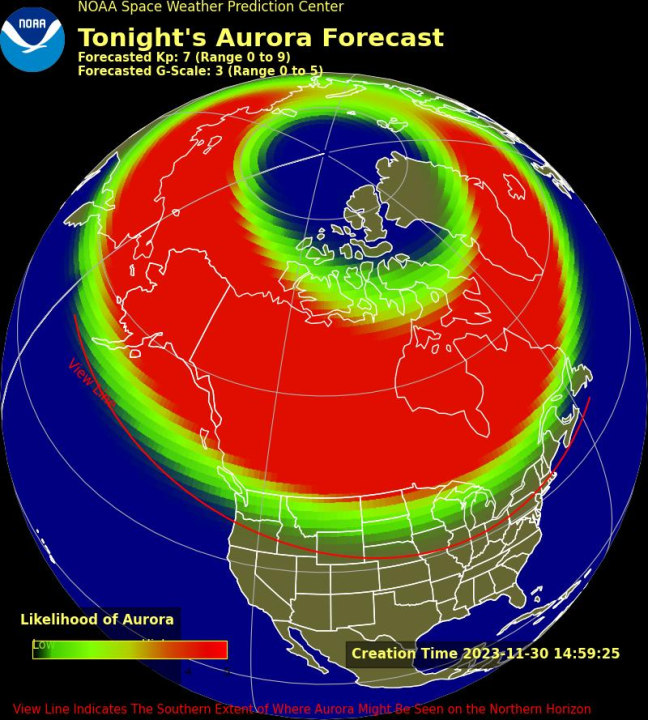Northern lights: More than 20 states have a chance at seeing the auroras Thursday
(NEXSTAR) — Multiple states have a chance at seeing the northern lights Thursday and into Friday, all thanks to an active bout of space weather.
NOAA’s Space Weather Prediction Center upgraded its geomagnetic storm watch for Friday, noting that multiple coronal mass ejections, or CMEs, are expected to impact Earth in the coming days.
With three CMEs already inbound and a fourth expected, forecasters upgraded the storm watch Wednesday evening to a G3 (on a strength scale of 1 to 5).
What causes the northern lights?
We get to see the northern lights when space weather — like CMEs and the geomagnetic storms associated with them — impact Earth.
CMEs are explosions of plasma and magnetic material from the sun that can impact navigation, communication and radio signals on Earth. They’re also able to cause auroras by creating currents in Earth’s magnetic fields that send particles to the North and South Poles, which then interact with oxygen and nitrogen, according to NASA.
The strength of the geomagnetic storm will impact how far south the northern lights will be visible. The SWPC uses a scale, similar to those used to measure tornadoes or hurricanes, to categorize the strength of a geomagnetic storm.
According to the scale, a minor G-1 storm leads to auroras commonly being visible in Maine and Michigan’s Upper Peninsula. A moderate G-2 storm can bring the northern lights slightly southward into New York and Idaho.
When a storm reaches G-3 status, an aurora can be viewed as far south as Illinois and Oregon. Should it reach G-4 strength, those living in Alabama and northern California may have a chance at seeing the northern lights. Solar activity that causes a G-5 storm, the highest possible on SWPC’s scale, has been known to make an aurora appear in Florida and even southern Texas (though other factors need to align to bring them that far south).
What states could see the northern lights tonight?
Current SWPC forecasts show many northern states have a chance at seeing the northern lights Thursday and into Friday. That includes Alaska, Montana, North Dakota and Minnesota, places with the greatest chance of seeing the auroras.
Other states that may get to experience the shimmering lights include Washington, Oregon, Idaho, South Dakota, Wyoming, Nebraska, Iowa, Wisconsin, Illinois, Indiana, Michigan, Ohio, Pennsylvania, New York, Vermont, Rhode Island, Massachusetts and Maine.
The map below shows the forecast for Thursday night. Areas in red have the greatest likelihood of seeing the auroras, while those in green are less likely to see them. The red line is considered the view line, so even those outside of the green and red areas could see the northern lights if they’re along that line.

Friday’s aurora forecast isn’t as promising for the Lower 48. Those in North Dakota and northern portions of Washington, Idaho, Montana, Minnesota, Wisconsin and Michigan’s Upper Peninsula have the best chance of seeing the northern lights.

The aurora forecast for Friday, Dec. 1, 2023. (NOAA’s Space Weather Prediction Center)
We could be seeing the northern lights more often
If you don’t catch the auroras Thursday, don’t worry — we’ll likely see even more in the coming months.
The sun is reaching the peak of Solar Cycle 25, an 11-year period in which the sun flips its magnetic poles, sparking space weather like CMEs and CH HSSs. New forecasts show it could come quicker and be stronger than previously thought from January to October next year.
That could not only mean more northern lights occurrences — with possibly more opportunities for those in the southern U.S. to see them — but impacts on our infrastructure.
An added bonus of the current solar cycle? The April 8, 2024, total solar eclipse will occur near cycle maximum, meaning a good show for skywatchers, NOAA explains.
Copyright 2024 Nexstar Media Inc. All rights reserved. This material may not be published, broadcast, rewritten, or redistributed..













